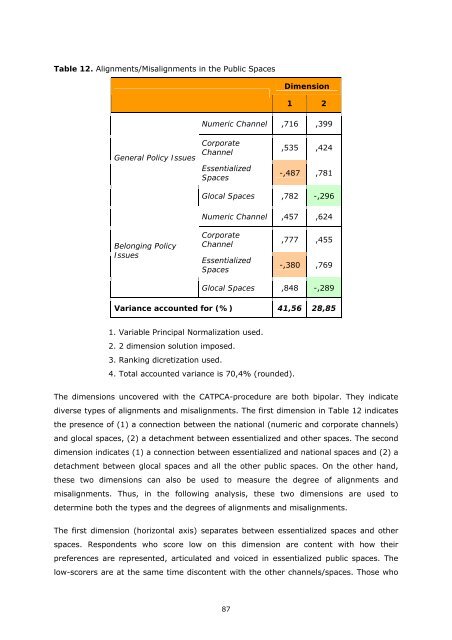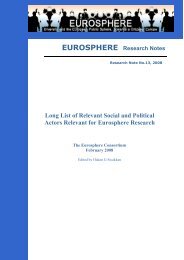Migrants, Minorities, Belongings and Citizenship. Glocalization and ...
Migrants, Minorities, Belongings and Citizenship. Glocalization and ...
Migrants, Minorities, Belongings and Citizenship. Glocalization and ...
You also want an ePaper? Increase the reach of your titles
YUMPU automatically turns print PDFs into web optimized ePapers that Google loves.
Table 12. Alignments/Misalignments in the Public Spaces<br />
Dimension<br />
1 2<br />
Numeric Channel ,716 ,399<br />
General Policy Issues<br />
Corporate<br />
Channel<br />
Essentialized<br />
Spaces<br />
,535 ,424<br />
-,487 ,781<br />
Glocal Spaces ,782 -,296<br />
Numeric Channel ,457 ,624<br />
Belonging Policy<br />
Issues<br />
Corporate<br />
Channel<br />
Essentialized<br />
Spaces<br />
,777 ,455<br />
-,380 ,769<br />
Glocal Spaces ,848 -,289<br />
Variance accounted for (%) 41,56 28,85<br />
1. Variable Principal Normalization used.<br />
2. 2 dimension solution imposed.<br />
3. Ranking dicretization used.<br />
4. Total accounted variance is 70,4% (rounded).<br />
The dimensions uncovered with the CATPCA-procedure are both bipolar. They indicate<br />
diverse types of alignments <strong>and</strong> misalignments. The first dimension in Table 12 indicates<br />
the presence of (1) a connection between the national (numeric <strong>and</strong> corporate channels)<br />
<strong>and</strong> glocal spaces, (2) a detachment between essentialized <strong>and</strong> other spaces. The second<br />
dimension indicates (1) a connection between essentialized <strong>and</strong> national spaces <strong>and</strong> (2) a<br />
detachment between glocal spaces <strong>and</strong> all the other public spaces. On the other h<strong>and</strong>,<br />
these two dimensions can also be used to measure the degree of alignments <strong>and</strong><br />
misalignments. Thus, in the following analysis, these two dimensions are used to<br />
determine both the types <strong>and</strong> the degrees of alignments <strong>and</strong> misalignments.<br />
The first dimension (horizontal axis) separates between essentialized spaces <strong>and</strong> other<br />
spaces. Respondents who score low on this dimension are content with how their<br />
preferences are represented, articulated <strong>and</strong> voiced in essentialized public spaces. The<br />
low-scorers are at the same time discontent with the other channels/spaces. Those who<br />
87











